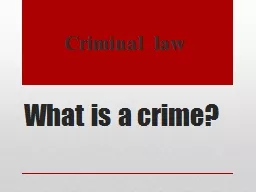

Criminal law 1 What are we going to learn about In this part you will learn about the principles of criminal liability crimes and defences the criminal investigation process and criminal sanctions ID: 376521
Download Presentation The PPT/PDF document "What is a crime?" is the property of its rightful owner. Permission is granted to download and print the materials on this web site for personal, non-commercial use only, and to display it on your personal computer provided you do not modify the materials and that you retain all copyright notices contained in the materials. By downloading content from our website, you accept the terms of this agreement.
Slide1
What is a crime?
Criminal law
1Slide2
What are we going to learn about?
In this part you will learn about:
the principles of criminal liability, crimes and defences
the criminal investigation process and criminal sanctions
trends in crime, sentencing and recidivismimpacts of crime and victims’ compensation.
2Slide3
So what is a crime?
3Slide4
What constitutes a crime is determined by what the law-makers (parliament and the courts) of the day declare it to be
. A crime is an act or omission (failure to act) that is
regarded as unacceptable
according to the law at the time and is
punishable by the state authorities. An act is deemed a crime because our community has declared that the behaviour is illegal. The concept of what a crime is can change over time and can vary between different cultures. Criminal law is therefore concerned with criminal behaviour which is against the law and harmful to society, and sets out the sanction (punishment) which will be imposed on those who breach the laws.
4Slide5
Features of crime
5Slide6
There are four key elements:
Crimes
are against the criminal law of the
state
Crimes are against moralityCrimes are harmful to societyCrimes are punishable6Slide7
1
. Crimes are against the criminal law of the state
Against existing law
Criminal law sets standard of behaviour
reflects the values of society
7Slide8
Our criminal laws reflect our beliefs on what is morally wrong.
E.g. Murder, Child abuse, sexual assault etc.
2. Crimes are against morality
8Slide9
3. Crimes are harmful to society
Certain type of behaviour is seen as harmful
Usually involves a victim
Harm can be physical, psychological, emotional, financial
9Slide10
4.Crimes are punishable by the state
Investigated by the policePunished through the courts
10Slide11
Sources of Criminal Law
Common Law – Laws made by the courts though court decisions on a matter currently before the court
Common Law – Initially derived from English Courts as we follow the
Westminister
SystemLegislationParliament & Delegated Authorities11Slide12
Elements of a crime
ACTUS REUS (Guilty Act
Mens
Rea (Guilty Mind)
In order to be found guilty of any crime (Except Strict Liabiity Crimes) the two elements of Actus Reus and Mens Rea need to be proved by the prosecution. Strict Liability Crimes – Some crimes do not require the prosecution to prove Mens Rea. Traffic offences are an example. Do not have to prove that you intended to speed (Guilty Mind) but just that you were speeding.
12Slide13
Age of criminal responsibility
Child under 10 cannot be charged with a criminal offence. Prosecution unable to prove
Mens
Rea.
Child under 10 is considered not to know or understand the consequences of their actionsChild between 10 and 14. Can be charged if the prosecution can prove that the child intended to commit the crime with ‘mischievous discretion’. i.e., knew what they were doing was wrong. 13Slide14
Presumption of innocence
The overriding principle is that ‘a person is considered innocent until proven guilty’.
Unless it is a reverse onus offence such as ‘possession of property suspected as being proceeds of crime’ a person charged is not required to prove their guilt or innocence.
The prosecution is required to prove the guilt of an individual charged
14Slide15
Burden and Standard of proof
Type
of crime
Burden
StandardCriminal
Prosecution
Beyond
reasonable doubt (There cannot be any doubt)
Civil
Plaintiff
Balance of probability (More probable
than not)
15
Not guilty does not mean innocent
Refers only to the fact that the prosecution failed to prove the crime to the relevant standardSlide16
Principal Offender/Abettor
Principal offender is a person who actually commits the crime. I.e., picks up the Mars Bar and takes it from the milk bar without paying for it.
An ‘Abettor’ is a person who assists the person to commit the crime. i.e., a person looking out for the store owner or someone else who may catch you steeling that mars bar.
An Abettor is a person who (a) Aids - (Helps) (b) Abets – (Encourages), (c) Counsels – (Advises), (d) – Procures (provides assistance with organisation)
https://www.youtube.com/watch?v=OINamP2-IzkJudy Moran Guilty of Murder
16Slide17
Accessory to a crime
An accessory
is a person who knows or believes the principal offender to be guilty of a serious indictable offence, yet impedes their apprehension, prosecution, conviction or punishment, without a lawful or reasonable excuse. A serious indictable offence is a crime that carries a punishment of five years or more in prison.
http://www.bendigoadvertiser.com.au/story/2504611/pair-plead-not-guilty-to-murder
/17Slide18
Task:
Complete questions 1 – 11 on Page 43 of student text.
18